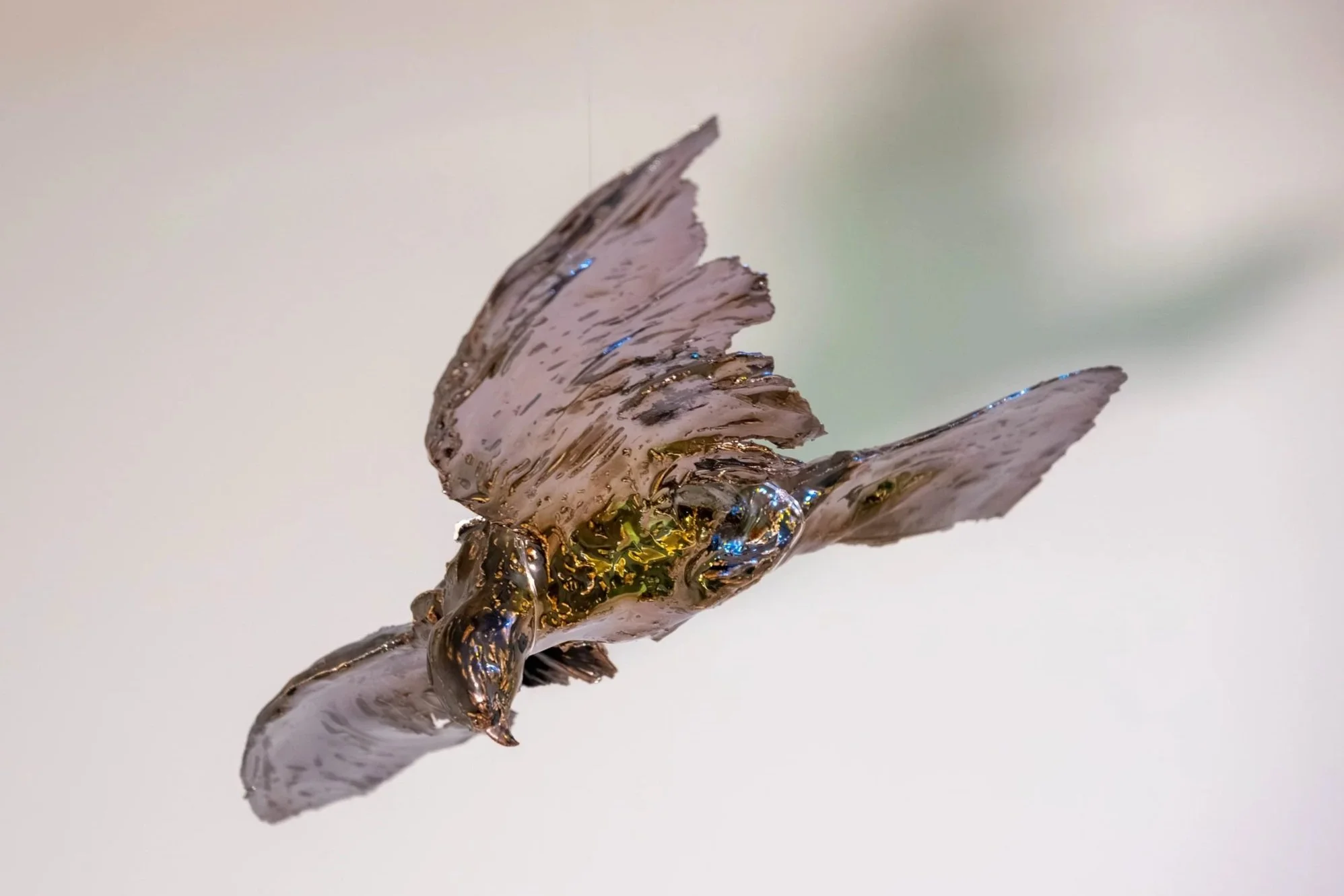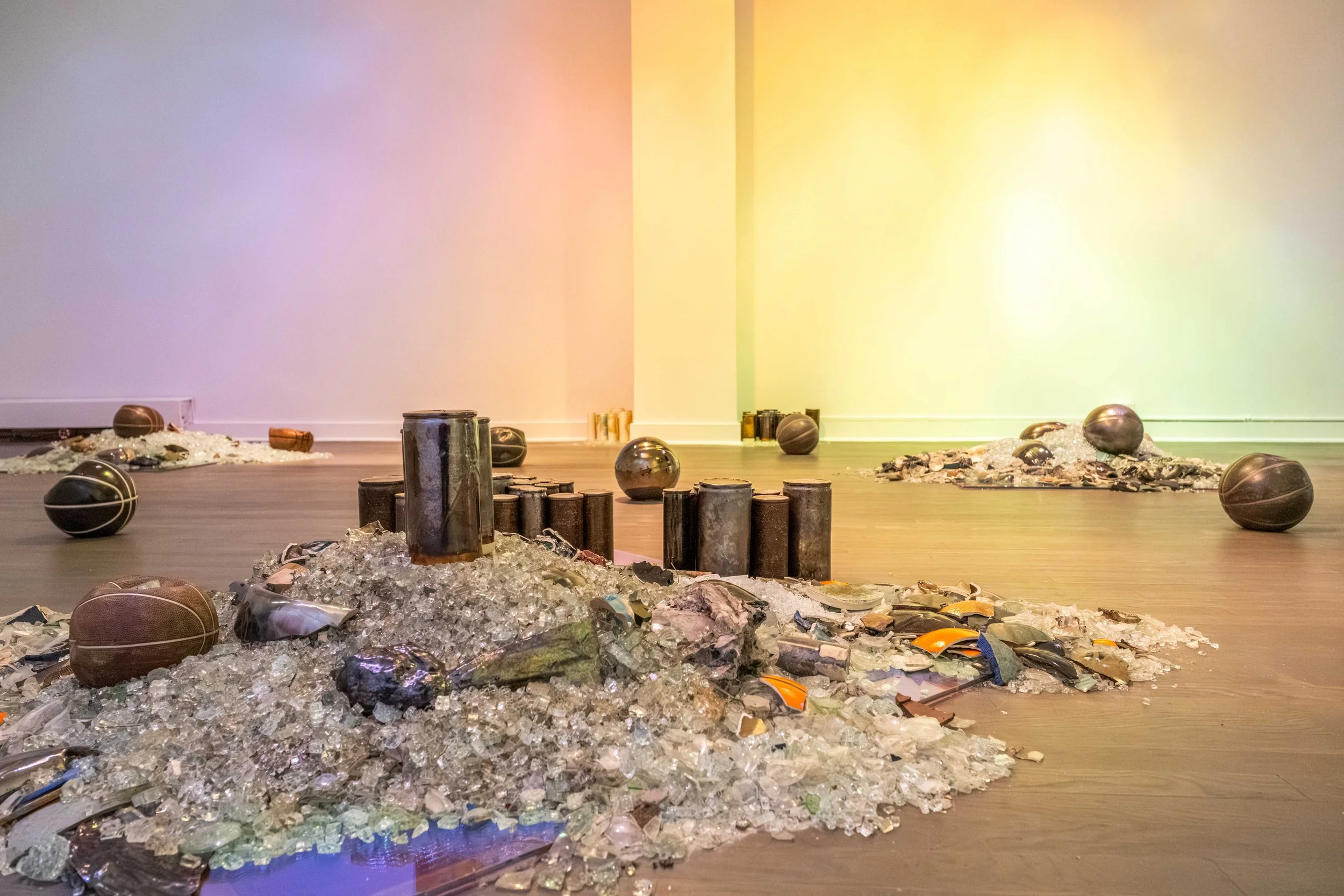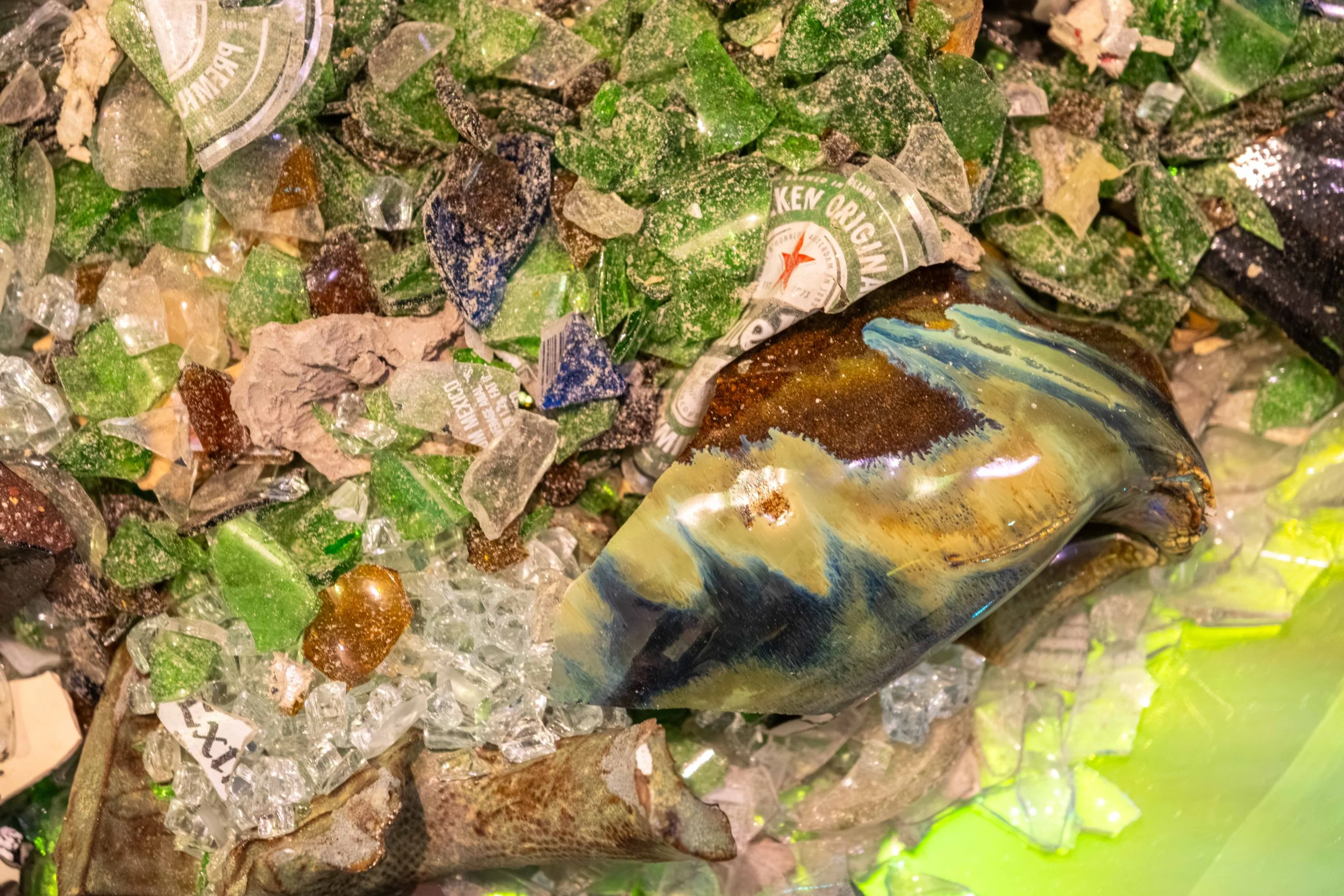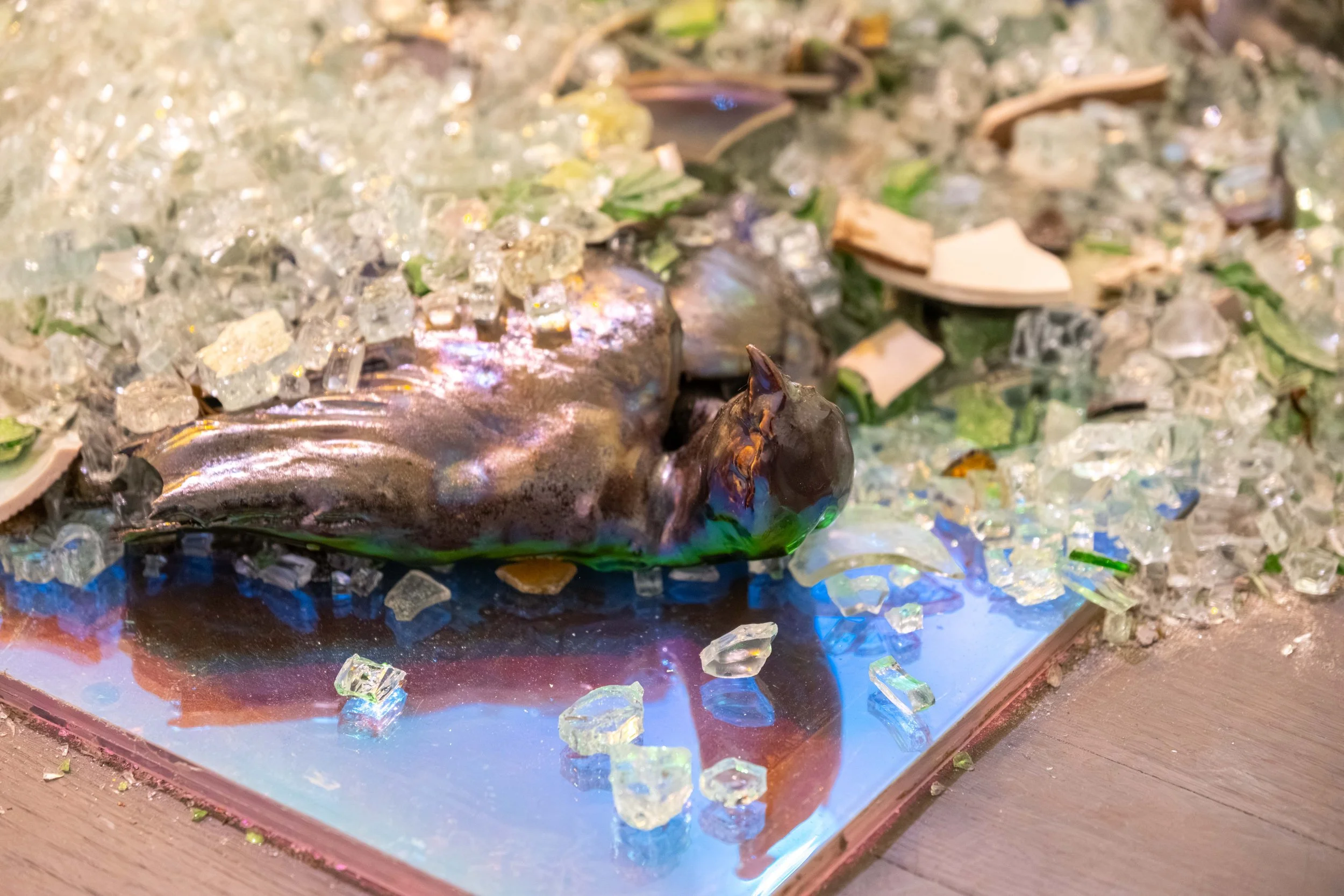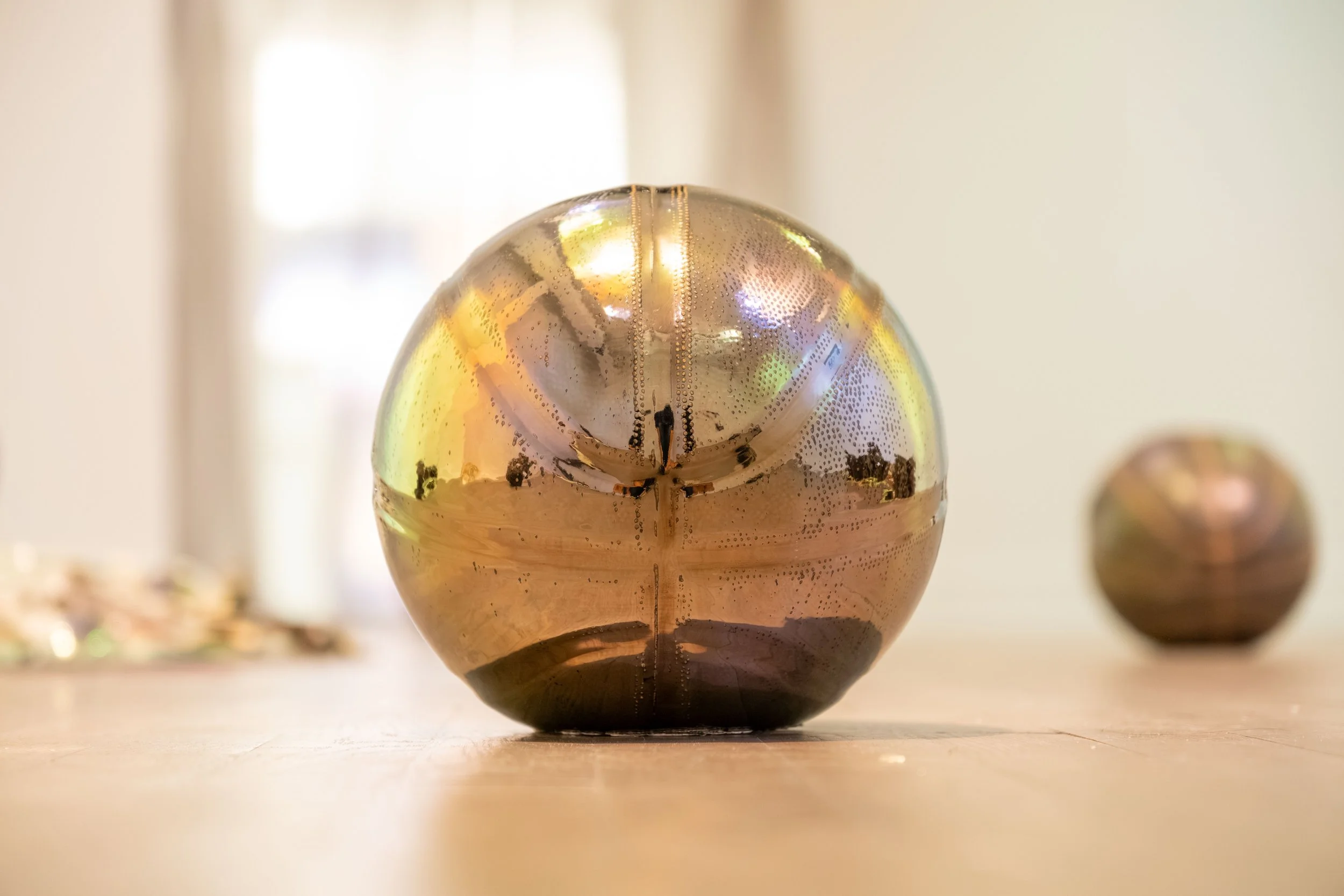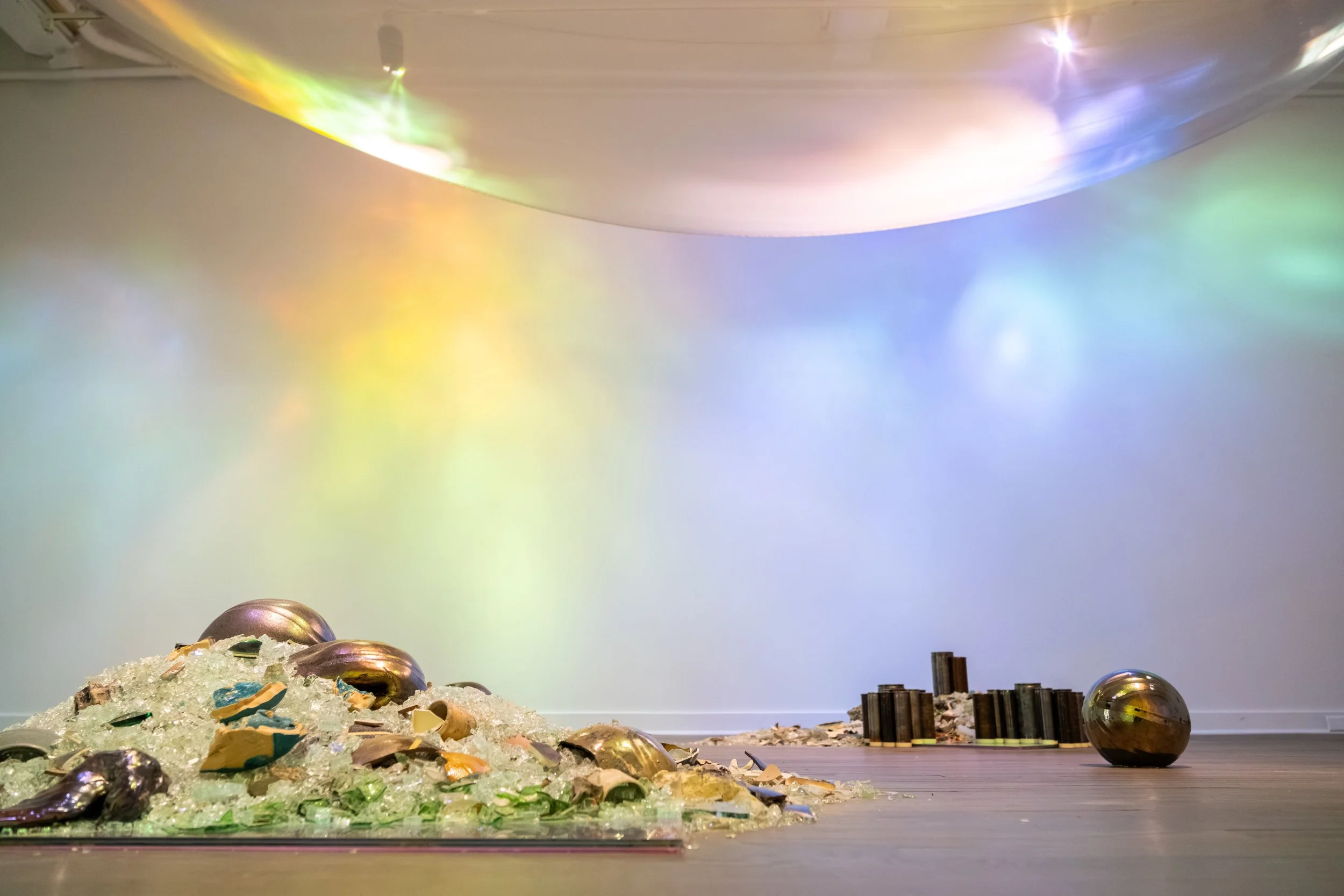Writer: Alliyah Allen
Essay Mentor: J Wortham
This essay was produced in conjunction with the exhibition Boomerang by Jairo Sosa, mentored by Hugh Hayden and on view at CUE Art from June 26 – October 18, 2025. The text was commissioned as part of CUE’s Art Critic Mentorship Program, and is included in the free exhibition catalogue available at CUE and online.
Sparrowhawk, 2025. Glazed stoneware; 3 x 18 x 12.5 inches. Photo by Leo Ng.
Walking between the ceramic basketballs arranged on the floor as part of Boomerang, Jairo Sosa’s solo exhibition at CUE, I felt as though I was on a distant playground, or the courts I frequented with my brothers growing up in Trenton, NJ. In kneeling to look closely at the surface of the balls, I could perceive their pebbles—the small, upraised dots that help players grip to dribble and pass. Some of the balls retained a perfect spherical form, and others were distorted, as if punctured, slackened, or deflated. A few contained crystal-like pools of glistening glass or ceramic deep within their hollowed pockets, as if they were collecting water that had begun to shimmer in the sunlight.
Glazed in idiosyncratic metallics intermixed with hues of brown, orange, and gray, the basketballs were so lifelike that they almost felt like an illusion, triggering memories that transported me back to recollections of home, and to coming of age in the city—an experience Sosa and I learned that we shared when we first met in graduate school. The basketballs of my youth, and perhaps of Sosa’s—were an object of childhood play, but also a symbol of hope and possibility. Within the context of the exhibition, their presence provokes questions about our relationship to place and memory, especially in complex urban environments. What is the material of our dreams, hopes, and aspirations?
Installation view of Boomerang by Jairo Sosa, 2025. Photo by Leo Ng.
Upon choosing a path through the arrangement of basketballs within the show, one encounters three mound-like configurations in which Sosa’s ceramic works are interspersed with various types of broken glass and shattered remnants of his ceramic slip-casting process. Shards of green with a partial Heineken or Corona logo peek through luminescent tempered architectural glass; thick pieces of dichroic and stained glass are contrasted by sharp fragments of ultra-thin scientific lab glass. Here and there, one perceives a wing of a bird, a candy wrapper, or a supermarket flyer announcing deals on Kraft mac & cheese and Scott toilet paper. Sosa transforms this everyday iconography—what some might see as urban litter—into a beautiful and transcendent world.
Installation view of Boomerang by Jairo Sosa, 2025. Photo by Leo Ng.
Atop one of the compositions and nestled within the corners of a column in the gallery sit abstracted altars composed of tall, slender ceramic forms cast by Sosa. Though they are materially distinct, one immediately understands their resemblance to the glass-encased prayer candles often used in street vigils to honor and remember the deceased. Bathed in a haze of ethereal light, they gesture towards the longstanding tradition of community gathering at sites of grief and loss.
Toward a back corner of the space, hovering just within sight, is a ceramic sparrowhawk, suspended from the ceiling and positioned as if it were undertaking a swift plunge into the field of basketballs and shattered glass that forms Sosa’s abstracted urban landscape. Cast from a plaster mold of a taxidermized specimen and painted in a deep prismatic glaze, the sparrowhawk is a reminder of the presence of non-human life in urban spaces. A solitary bird of prey, it is known to adapt to the city, vigilantly scanning for its food and watching for opportunities that allow it to thrive. While this particular sparrowhawk soars high in the sky, elsewhere in the installation, its peers have met a different fate.
Installation view of Boomerang by Jairo Sosa, 2025. Photo by Leo Ng.
Through Boomerang, Sosa presents a materially rich installation of seemingly disparate elements that astutely plays with notions of brokenness and fragmentation. Tragedy is visceral in the room; its sensation is embedded in the shards of glass, the deflated basketballs, the remembrance candles, and the broken wings—symbols that conjure a relentless tide of structural violence and systemic racism that undergirds the urban experience, and that can dampen the agency of even the most willful of souls.
And yet, Sosa stages interventions of light, movement, and materiality that do not allow for despair to take hold. Where there is fracture, a spectrum of iridescent glazes (with titles such as Solar Rainbow and Dark Star) shines through, and our gaze is elevated through lighting that diffuses a soft array of pinks, greens, blues, and yellows upward throughout the gallery space. The colors imbue the space—and the reflective surfaces of the ceramic and glass-based works—with a cosmic saturation and a gentle atmosphere, one that is contemplative, transcendent, and untethered to any one particular meaning or conclusion. The movements one must make to step between and around the constellation of floor-based works become an embodied experience where agency and intention are evoked and upheld. The subtleties of texture and abstractions of form in the ceramic-based works offer opportunities for the viewer to push beyond—or discover what else might be—as we return to the familiar.
Hoop Dreams Deflate series, 2024. Glazed stoneware; 8.5 x 9.5 x 9 inches. Photo by Leo Ng.
Boomerang unsettles the ever-present city, sublimating Sosa’s use of iconography into mythic registers and transforming the space of the gallery into a meditative site that protects our deepest desires and intentions. Within this space, there exists a sense of peace, but also tensions and questions that are palpable. How do we stay in the game when the pressure is immense—when the forces of gravity deflate our dreams? When do we alchemize loss into something greater than melancholy or pain? What is at stake when freedom is jeopardized or lost? Do we endure, tolerating what’s given, supposed, or left behind—or do we surrender to uncertainty with the understanding that even predators might not catch their prey? Throughout the work, Sosa’s conception of mobility is present, yet fleeting. There is an undeniable reality, however, that something—or rather someone: a teammate, neighbors, family, or friends, is still present. To recognize, appreciate, or even revel in this spirit might take leaving oneself, pushing beyond what we survive every day.
Through Sosa’s works, I found myself contemplating how time and space can both limit and expand how we remember, especially in a context as complex and rich as urban life. What may look like decay and brokenness carries stories of systemic power imbalances, but also of humanity—of struggle and perseverance buried deep within the structures and spaces families and communities have occupied for generations. Perhaps they are waiting to be unearthed and read anew.
Boomerang has left me with the resounding call that we are not passive in this field of uncertainty and possibility. Although the environment may appear fixed, rugged, and often unwieldy, our narratives take up space, spurring presence and visibility as a means of flight. Through the simplicity of the everyday, we can come to understand ourselves and our histories as vast and connective, uniting across cities and time. Sosa’s work prompts us to persist in the promise to find and carry our stories forward, anchored by remembrance and care.
Installation view of Boomerang by Jairo Sosa, 2025. Photo by Leo Ng.
About the Writer
Alliyah Allen is a Newark-based independent curator and arts administrator whose work explores the intersections of Black visual culture, community archives, and alternative art spaces. Formerly Associate Curator and Program Director at Express Newark, she has led major exhibitions and community-centered programs that foreground marginalized perspectives and sustain socially engaged practices by contemporary artists at various stages of their careers. Her recent projects include Blues People (2024), Willie Cole’s Art Interventions (2023), and the forthcoming retrospective In Dreamtime: Aljira, A Center for Contemporary Art, 1983–2018, opening at The Newark Museum of Art in 2026. Allen holds an MA in Modern and Contemporary Art: Critical and Curatorial Studies from Columbia University.
About the Writing Mentor
J Wortham (they/them) is a sound healer, reiki practitioner, herbalist, and community care worker oriented toward healing justice and liberation. J is also a staff writer for The New York Times Magazine, and co-host of the podcast Still Processing. They occasionally publish a newsletter with thoughts on culture, technology, and wellness.
J is the proud editor, along with Kimberly Drew, of the visual anthology Black Futures (New York: One World), a 2020 editor's choice of The New York Times Book Review. J is also currently working on a book about the body and dissociation for Penguin Press. J mostly lives and works on stolen Munsee Lenape land (now known as Brooklyn, New York), and is committed to decolonization as a way of life.
About the Art Critic Mentorship Program
This text was written as part of the Art Critic Mentorship Program, a partnership between CUE and the AICA-USA (the US section of International Association of Art Critics). The program pairs emerging writers with art critic mentors to produce original essays about the work of artists exhibiting at CUE. Learn more about the program here. No part of this essay may be reproduced without prior written consent from the author.

